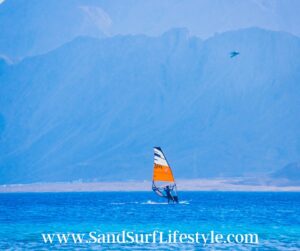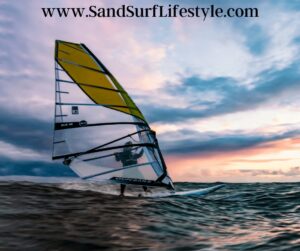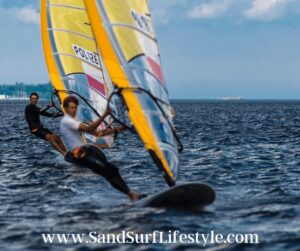Having the right gear before you start windsurfing can make or break your experience. While you don’t need the best, most expensive gear on the market, it’s important to know what you actually need before you make the commitment. What equipment do you need, and what should you look for?
But what is windsurfing, and what makes the equipment work? What should you look for in your first windsurfing board, and why does the sail need to be smaller when you start out? Read on more to find out.
What is windsurfing?
 Windsurfing is a surface water sport that combines surfing and sailing. It is popular in locations that have flatwater since surfers use a board and an attached sail to both surf and maintain balance. Board sizes vary depending on the activity—windsurfers can use shortboards for planing, which is when both the surfer and board move across the water due to speed rather than buoyancy. Longboards, on the other hand, are used when the winds are lighter or if the windsurfer is racing. When it comes to the sail, the larger the sail, the stronger the windsurfer must be to control it.
Windsurfing is a surface water sport that combines surfing and sailing. It is popular in locations that have flatwater since surfers use a board and an attached sail to both surf and maintain balance. Board sizes vary depending on the activity—windsurfers can use shortboards for planing, which is when both the surfer and board move across the water due to speed rather than buoyancy. Longboards, on the other hand, are used when the winds are lighter or if the windsurfer is racing. When it comes to the sail, the larger the sail, the stronger the windsurfer must be to control it.
When it comes to the history of windsurfing, it started in the 1960s, growing in popularity through the 1980s. It was recognized for the first time in the Olympics in 1984.
While windsurfing isn’t always an extreme sport, it really depends on the rider and what they wish to do while on the water. Making it an extreme sport means aerial jumps and tricks, which is totally possible when windsurfing, and each one has a particular style—wave riding is much like surfing, but with the sail in windsurfing, the surfer can catch the wind to gain speed.
Big wave riding is another style, which is when surfers seek waves that are over 30 feet high. The most experienced windsurfers can attempt storm riding, which is when a storm is forecasted to have over 60-knot winds—over 70 miles per hour. Because of the danger associated with this, it should only be attempted by experienced windsurfers.
Essential Equipment for Beginners
While you may just be starting out on windsurfing, it’s still important to have certain equipment before you head out into the water. While you don’t need brand new equipment across the board, you do need to have the proper fitting and properly sized equipment.
1. Windsurfing Board
Naturally, the board is the most important part of compiling your equipment. The bigger the board, the more stable the ride, which is best for beginners to the sport.
The typical size for beginner boards is listed in liters of volume, which is between 140 liters and 200 liters. Usually, one liter of volume can support one kilogram of weight, but you’ll have to add extra to your weight to counteract the weight of your sail, mast, and boom—adding 50 to 80 liters to your board’s expected volume will give you the best idea of how large of a board you need. For example, a surfer weighing 100 kilograms should have a board that is 150 to 180 liters in volume.
It should also sport a wider width, making it much easier to control. Beginner boards should come in around 75 to 95 centimeters.
Construction of the board is also important considering where you plan on sailing. If you are sailing in a location with light winds, like somewhere more inland, consider getting a board that has a daggerboard fin. These fins, retractable or not, will help you stay upright when the winds are much lighter.
You can also use a smaller fin, which helps in strong winds and for making faster turns. A larger fin helps with weaker winds and supports a larger sail. Beginners are encouraged to use a smaller fin to build up skills.
The best windsurfing boards on the market right now for beginners include the BIC Sport Techno One 293 or the Aqua Marine Blade Inflatable Board.
2. Sail
The second most important piece of equipment before you start windsurfing is your sail. There are several factors to consider before you purchase, including the size, your skill level, and the wind strength in your home base.
The smaller the sail, the better for beginners, as you can control it easier in any sort of wind. Beginner sails are usually sized between 5 and 6 square meters, making them much easier to pull out of the water.
If you’re taking lessons from a trained professional, it’s likely you’ll be using a training sail, which is under 5 square meters. If you’re using a training sail, you may want to wait to purchase your own, as, by the time you learn to use one, you will want to size up.
If you stick with the BIC Sport Techno One 293, you will have to purchase your own sail, while the Aqua Marine Blade Inflatable Board, you can purchase an add-on from the company. The Neil Pryde Ryde is a great sail for beginners, but the brands Naish and North Sail also make beginner sails.
Is windsurfing easier than kitesurfing? Find out here.
3. Mast and Mast Base
 Once you have your board and your sail, you’ll need something to attach them together—that’s where the mast comes in. Don’t overlook this important piece of equipment because it will add extra weight to your board and possibly change how your board rides. You should also consider how the mast fits into your board—if you get an ill-fitting mast or sail, you may not be able to progress past your beginner stage or you may learn the improper technique.
Once you have your board and your sail, you’ll need something to attach them together—that’s where the mast comes in. Don’t overlook this important piece of equipment because it will add extra weight to your board and possibly change how your board rides. You should also consider how the mast fits into your board—if you get an ill-fitting mast or sail, you may not be able to progress past your beginner stage or you may learn the improper technique.
Smaller beginner sails work best with a smaller diameter mast and should be curved to catch the wind. If your sail is under 7 square meters, a reduced-diameter mast will function best for you.
Because your mast is dependent on the type of sail you purchase, make sure you check to see if your sail is compatible. That being said, check out Neil Pryde, Naish, and North Sail for your setup.
4. Boom
For experienced sailors, they know what the boom is on their boats, and it serves the same purpose on your windsurfing rig. It is the piece that attaches to the mast, letting you unfurl your sail and keep control of the sail while on the water. It is also the piece of which the windsurfer grips when surfing.
This is a very important piece of equipment because it is the main source of control for the windsurfer. Most are made out of aluminum, but carbon booms are also functional if you wish to upgrade down the road.
Again, your boom is dependent on your sail and your mast set up, so staying with the same brand you purchased the other items from is preferable. Neil Pryde, Naish, and North Sail are decent brands to consider if you’re looking at their sails as well.
5. Safety Equipment
While knowing how to properly swim is imperative before you start any sort of water-based sport, you should also consider using some sort of safety equipment. While it may add weight to your board, consider using some sort of flotation device or buoyancy aid if you’re just starting out windsurfing.
Buoyancy aids aren’t just for helping you stay afloat—they can also work as impact vests. If you end up taking a hard fall, they can not only help you stay above the water, but they can protect your core and save you from serious injury.
A personal flotation device isn’t the only way you can stay safe while windsurfing—don’t neglect using a helmet. When you’re sailing at high speeds, you don’t know how easily you can fall off your board, whether you’re using foot straps or not. A helmet is useful when you’re first starting out—make sure if you use a helmet, it’s built specifically for windsurfing and fits properly.
Neil Pryde makes a line of safety gear, along with ProLimit.
6. Proper Clothing
Going out into the water may just elicit thoughts of swimsuits and sunglasses but starting to windsurf means you need to have the proper clothing before you head out. Wetsuits can both keep you warm and protect you against any sort of injuries you make get during your session.
Beginner windsurfing wetsuits should be between 2.5 to 3 millimeters thick to strike a balance between protection and comfort. It should fit snug, but not tight—it could cause health problems if the wetsuit is too tight. The colder the water, the thicker the wetsuit, so check with your local weather conditions before you purchase your own.
While you could use a surfing wetsuit, there are windsurfing specific wetsuits on the market that are made for the activities you’re doing, such as giving you more flexibility around the forearms in order to move the boom easier.
You should also consider some sort of footwear. While bulky footwear may make using your foot straps on your board, try using some sort of water shoe or rubber-soled neoprene boots to protect your feet from the cold water and have more comfort on your board.
And while you may not think sunglasses are important, you can use them while windsurfing and they can help you see on particularly sunny days. When you’re looking for sunglasses specifically for water sports, you should find a pair that has anti-impact protection, good ventilation, a head strap, and a hydrophobic coating. That way, your glasses will be protected (and so will your face!), they will stay on without fogging up your lenses, and water will slide off without obstructing your view.
Isthmus sells a range of wetsuits and gear, while O’Neill also leads the industry in the best windsurfing clothing.
7. Transport and Storage System
 Considering where you’re planning on storing your equipment may not be first on your mind, but if you’re looking into making windsurfing part of your life, you need a place to store and a way to transport your equipment from your home to the water. Roof racks are an easy way to transport your board, sail, and rig to the beach.
Considering where you’re planning on storing your equipment may not be first on your mind, but if you’re looking into making windsurfing part of your life, you need a place to store and a way to transport your equipment from your home to the water. Roof racks are an easy way to transport your board, sail, and rig to the beach.
Because your rig and board do take up a lot of room, consider where you’re going to store it. Note that you shouldn’t store them outside—boards and equipment are susceptible to damage from the sun’s rays.
Triji Surf and Rack Attack have roof racks for your car—and not just for windsurfing.
While it may be daunting to consider on your own, there are experts out there that can help you find the right board for your skill level and your needs. Consider going to a windsurfing or surf shop and ask them what they think is right for you—they may have the insight you haven’t considered yet.
Investing in the proper equipment can make or break your experience, and the better the quality, the better your ride. As you learn how each piece fits together into the grand scheme of the sport, you can start to make decisions on what you want out of your own rig, so when you rank up to an intermediate windsurfer, you can decide exactly what pieces and designs of your new equipment should be and what they should look like.
Please note: This blog post is for educational purposes only and does not constitute legal or medical advice. Please consult a legal expert or medical professional to address your specific needs.

